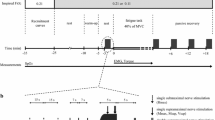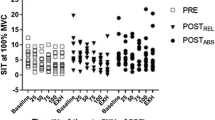Abstract
We hypothesized that if reduced spinal excitability contributes to central activation failure, then a caffeine-induced increase in spinal excitability would enhance postfatigue maximal voluntary activation and maximal voluntary contraction (MVC). Ten male volunteer subjects attended two laboratory sessions separated by at least 1 week. Contractile and electrical properties were assessed before, and 1 h after oral administration of caffeine (6 mg/kg) or placebo (all-purpose flour), and again following a fatigue protocol. The slope of the H reflex recruitment curve, normalized to that of the M wave (H slp/M slp), was used to estimate spinal excitability. Maximal voluntary activation was assessed using maximal EMG (EMGmax) and twitch interpolation. Postfatigue, MVC torque declined (P<0.05) to 75.2±12.7 and 70.2±9.3% of the prefatigue values in the placebo (PL) and caffeine (CF) trials, respectively, and remained depressed throughout the recovery period. This was accompanied by a decline in % activation (P<0.05) from 99.6±0.3% (PL) and 99.8±0.3% (CF) to 94.8±3.5% (PL) and 95.3±5.0% (CF), indicating the presence of central activation failure. Caffeine offset the decline in H slp/M slp observed in the placebo trial (P<0.05), but it did not prevent the decline in maximal voluntary activation or MVC torque. Furthermore, although the decline in spinal excitability was correlated to the decline in EMGmax (r=0.55, P<0.05) it was not correlated with the decline in % activation or MVC torque. Thus a fatigue-induced decline in spinal excitability did not limit maximal activation.







Similar content being viewed by others
References
Abernethy DR, Todd EL (1985) Impairment of caffeine clearance by chronic use of low-dose oestrogen-containing oral contraceptives. Eur J Clin Pharmacol 28:425–428
Allen GM, Gandevia SC, McKenzie DK (1995) Reliability of measurements of muscle strength and voluntary activation using twitch interpolation. Muscle Nerve 18:593–600
Avela J, Kyrolainen H, Komi PV, Rama D (1999) Reduced reflex sensitivity persists several days after long-lasting stretch-shortening cycle exercise. J Appl Physiol 86:1292–1300
Avela J, Kyrolainen H, Komi PV (2001) Neuromuscular changes after long-lasting mechanically and electrically elicited fatigue. Eur J Appl Physiol 85:317–325
Bangsbo J, Jacobsen K, Nordberg N, Christensen NJ, Graham T (1992) Acute and habitual caffeine ingestion and metabolic responses to steady-state exercise. J Appl Physiol 72:1297–1303
Behm DG (2004) Force maintenance with submaximal fatiguing contractions. Can J Appl Physiol 29:274–290
Bentley DJ, Smith PA, Davie AJ, Zhou S (2000) Muscle activation of the knee extensors following high intensity endurance exercise in cyclists. Eur J Appl Physiol 81:297–302
Bongiovanni LG, Hagbarth KE (1990) Tonic vibration reflexes elicited during fatigue from maximal voluntary contractions in man. J Physiol 423:1–14
Brasil-Neto JP, Pascual-Leone A, Valls-Sole J, Cammarota A, Cohen LG, Hallett M (1993) Postexercise depression of motor evoked potentials: a measure of central nervous system fatigue. Exp Brain Res 93:181–184
Christie A, Lester S, LaPierre D, Gabriel DA (2004) Reliability of a new measure of H-reflex excitability. Clin Neurophysiol 115:116–123
Daniels JW, Mole PA, Shaffrath JD, Stebbins CL (1998) Effects of caffeine on blood pressure, heart rate, and forearm blood flow during dynamic leg exercise. J Appl Physiol 85:154–159
Duchateau J, Hainaut K (1993) Behaviour of short and long latency reflexes in fatigued human muscles. J Physiol 471:787–799
Duchateau J, Balestra C, Carpentier A, Hainaut K (2002) Reflex regulation during sustained and intermittent submaximal contractions in humans. J Physiol 541:959–967
Farina D, Merletti R, Enoka RM (2004) The extraction of neural strategies from the surface EMG. J Appl Physiol 96:1486–1495
Fredholm BB (1995) Astra Award Lecture. Adenosine, adenosine receptors and the actions of caffeine. Pharmacol Toxicol 76:93–101
Fuglevand AJ, Keen DA (2003) Re-evaluation of muscle wisdom in the human adductor pollicis using physiological rates of stimulation. J Physiol 549:865–875
Funase K, Imanaka K, Nishihira Y (1994) Excitability of the soleus motoneuron pool revealed by the developmental slope of the H-reflex as reflex gain. Electromyogr Clin Neurophysiol 34:477–489
Gandevia SC (2001) Spinal and supraspinal factors in human muscle fatigue. Physiol Rev 81:1725–1789
Gandevia SC, Allen GM, Butler JE, Taylor JL (1996) Supraspinal factors in human muscle fatigue: evidence for suboptimal output from the motor cortex. J Physiol 490(Pt 2):529–536
Garland SJ (1991) Role of small diameter afferents in reflex inhibition during human muscle fatigue. J Physiol 435:547–558
Garland SJ, McComas AJ (1990) Reflex inhibition of human soleus muscle during fatigue. J Physiol 429:17–27
Gorassini MA, Bennett DJ, Yang JF (1998) Self-sustained firing of human motor units. Neurosci Lett 247:13–16
Graham TE, Spriet LL (1995) Metabolic, catecholamine, and exercise performance responses to various doses of caffeine. J Appl Physiol 78:867–874
Graham TE, Helge JW, MacLean DA, Kiens B, Richter EA (2000) Caffeine ingestion does not alter carbohydrate or fat metabolism in human skeletal muscle during exercise. J Physiol 529(Pt 3):837–847
Greer F, McLean C, Graham TE (1998) Caffeine, performance, and metabolism during repeated Wingate exercise tests. J Appl Physiol 85:1502–1508
Griffin L, Garland SJ, Ivanova T, Gossen ER (2001) Muscle vibration sustains motor unit firing rate during submaximal isometric fatigue in humans. J Physiol 535:929–936
Hultborn H, Kiehn O (1992) Neuromodulation of vertebrate motor neuron membrane properties. Curr Opin Neurobiol 2:770–775
Hultborn H, Meunier S, Morin C, Pierrot-Deseilligny E (1987) Assessing changes in presynaptic inhibition of I a fibres: a study in man and the cat. J Physiol 389:729–756
James RS, Wilson RS, Askew GN (2004) Effects of caffeine on mouse skeletal muscle power output during recovery from fatigue. J Appl Physiol 96:545–552
Kalezic I, Bugaychenko LA, Kostyukov AI, Pilyavskii AI, Ljubisavljevic M, Windhorst U, Johansson H (2004) Fatigue-related depression of the feline monosynaptic gastrocnemius-soleus reflex. J Physiol (Lond) 556:283–296
Kalmar JM, Cafarelli E (1999) Effects of caffeine on neuromuscular function. J Appl Physiol 87:801–808
Kalmar JM, Cafarelli E (2004a) Caffeine: a valuable tool to study central fatigue in humans? Exerc Sport Sci Rev 32:143–147
Kalmar JM, Cafarelli E (2004b) Central fatigue and transcranial magnetic stimulation: effect of caffeine and the confound of peripheral transmission failure. J Neurosci Methods 138:15–26
Kamimori GH, Somani SM, Knowlton RG, Perkins RM (1987) The effects of obesity and exercise on the pharmacokinetics of caffeine in lean and obese volunteers. Eur J Clin Pharmacol 31:595–600
Kent-Braun JA (1999) Central and peripheral contributions to muscle fatigue in humans during sustained maximal effort. Eur J Appl Physiol Occup Physiol 80:57–63
Kiehn O, Eken T (1997) Prolonged firing in motor units: evidence of plateau potentials in human motoneurons? J Neurophysiol 78:3061–3068
Kuchinad RA, Ivanova TD, Garland SJ (2004) Modulation of motor unit discharge rate and H-reflex amplitude during submaximal fatigue of the human soleus muscle. Exp Brain Res 158:345–355
Lane JD, Steege JF, Rupp SL, Kuhn CM (1992) Menstrual cycle effects on caffeine elimination in the human female. Eur J Clin Pharmacol 43:543–546
Lopes JM, Aubier M, Jardim J, Aranda JV, Macklem PT (1983) Effect of caffeine on skeletal muscle function before and after fatigue. J Appl Physiol 54:1303–1305
Loscher WN, Cresswell AG, Thorstensson A (1996) Excitatory drive to the alpha-motoneuron pool during a fatiguing submaximal contraction in man. J Physiol 491(Pt 1):271–280
Macefield G, Hagbarth KE, Gorman R, Gandevia SC, Burke D (1991) Decline in spindle support to alpha-motoneurones during sustained voluntary contractions. J Physiol 440:497–512
Macefield VG, Gandevia SC, Bigland-Ritchie B, Gorman RB, Burke D (1993) The firing rates of human motoneurones voluntarily activated in the absence of muscle afferent feedback. J Physiol 471:429–443
Marsden CD, Meadows JC, Merton PA (1983) “Muscular wisdom” that minimizes fatigue during prolonged effort in man: peak rates of motoneuron discharge and slowing of discharge during fatigue. Adv Neurol 39:169–211
Moritani T, Muro M, Kijima A, Gaffney FA, Parsons D (1985) Electromechanical changes during electrically induced and maximal voluntary contractions: surface and intramuscular EMG responses during sustained maximal voluntary contraction. Exp Neurol 88:484–499
Nordlund MM, Thorstensson A, Cresswell AG (2004) Central and peripheral contributions to fatigue in relation to level of activation during repeated maximal voluntary isometric plantar flexions. J Appl Physiol 96:218–225
Parsons WD, Neims AH (1978) Effect of smoking on caffeine clearance. Clin Pharmacol Ther 24:40–45
Pettorossi VE, Della TG, Bortolami R, Brunetti O (1999a) The role of capsaicin-sensitive muscle afferents in fatigue-induced modulation of the monosynaptic reflex in the rat. J Physiol 515(Pt 2):599–607
Pettorossi VE, Torre GD, Bortolami R, Brunetti O (1999b) The role of capsaicin-sensitive muscle afferents in fatigue-induced modulation of the monosynaptic reflex in the rat. J Physiol (Lond) 515:599–607
Plaskett CJ, Cafarelli E (2001) Caffeine increases endurance and attenuates force sensation during submaximal isometric contractions. J Appl Physiol 91:1535–1544
Radegran G, Calbet JA (2001) Role of adenosine in exercise-induced human skeletal muscle vasodilatation. Acta Physiol Scand 171:177–185
Rossi A, Decchi B, Ginanneschi F (1999) Presynaptic excitability changes of group Ia fibres to muscle nociceptive stimulation in humans. Brain Research 818:12–22
Rudomin P, Schmidt RF (1999) Presynaptic inhibition in the vertebrate spinal cord revisited. Exp Brain Res 129:1–37
Samii A, Wassermann EM, Ikoma K, Mercuri B, Hallett M (1996) Characterization of postexercise facilitation and depression of motor evoked potentials to transcranial magnetic stimulation. Neurology 46:1376–1382
Samii A, Wassermann EM, Hallett M (1997) Post-exercise depression of motor evoked potentials as a function of exercise duration. Electroencephalogr Clin Neurophysiol 105:352–356
Schieppati M (1987) The Hoffmann reflex: a means of assessing spinal reflex excitability and its descending control in man. Prog Neurobiol 28:345–376
Tanino Y, Daikuya S, Nishimori T, Takasaki K, Kanei K, Suzuki T (2004) H-reflex and reciprocal Ia inhibition after fatiguing isometric voluntary contraction in soleus muscle. Electromyogr Clin Neurophysiol 44:473–476
Tarnopolsky M, Cupido C (2000) Caffeine potentiates low frequency skeletal muscle force in habitual and nonhabitual caffeine consumers. J Appl Physiol 89:1719–1724
Taylor JL, Allen GM, Butler JE, Gandevia SC (2000a) Supraspinal fatigue during intermittent maximal voluntary contractions of the human elbow flexors. J Appl Physiol 89:305–313
Taylor JL, Petersen N, Butler JE, Gandevia SC (2000b) Ischaemia after exercise does not reduce responses of human motoneurones to cortical or corticospinal tract stimulation. J Physiol 525(Pt 3):793–801
Tergau F, Geese R, Bauer A, Baur S, Paulus W, Reimers CD (2000) Motor cortex fatigue in sports measured by transcranial magnetic double stimulation. Med Sci Sports Exerc 32:1942–1948
Todd G, Gorman RB, Gandevia SC (2004) Measurement and reproducibility of strength and voluntary activation of lower-limb muscles. Muscle Nerve 29:834–842
Trimble MH, Harp SS (1998) Postexercise potentiation of the H-reflex in humans. Med Sci Sports Exerc 30:933–941
Walton C, Kalmar J, Cafarelli E (2003) Caffeine increases spinal excitability in humans. Muscle Nerve 28:359–364
Walton C, Kalmar JM, Cafarelli E (2002a) Effect of caffeine on self-sustained firing in human motor units. J Physiol 545:671–679
Walton DM, Kuchinad RA, Ivanova TD, Garland SJ (2002b) Reflex inhibition during muscle fatigue in endurance-trained and sedentary individuals. Eur J Appl Physiol 87:462–468
Author information
Authors and Affiliations
Corresponding author
Additional information
This study was supported by a Reebok Research Grant on Human Performance and Injury Prevention from the American College of Sports Medicine Foundation and a NSERC PGS-B scholarship to J. Kalmar as well as NSERC grant A-6655 to E. Cafarelli.
Rights and permissions
About this article
Cite this article
Kalmar, J.M., Del Balso, C. & Cafarelli, E. Increased spinal excitability does not offset central activation failure. Exp Brain Res 173, 446–457 (2006). https://doi.org/10.1007/s00221-006-0383-0
Received:
Accepted:
Published:
Issue Date:
DOI: https://doi.org/10.1007/s00221-006-0383-0




